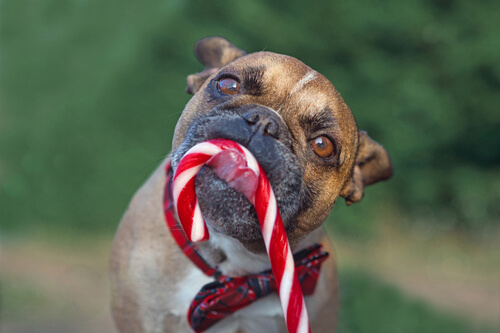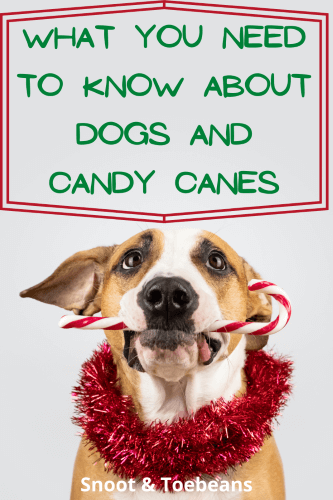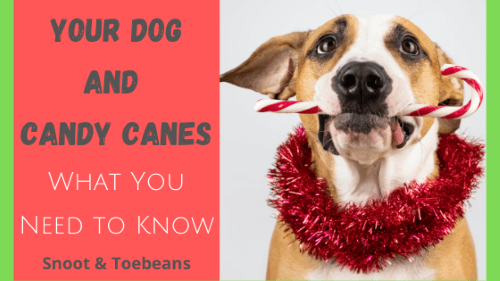Disclosure: My dog blog is supported by dog parents just like you. I only recommend products that I would use on my dogs. All opinions expressed here are my own. I sometimes earn a small affiliate commission, at no extra cost to you, when you click through the affiliate link and purchase something. You can read more about my affiliate policy here.
Candy canes have always been a staple during the Christmas season. They are used as a representation of the story of Jesus and trees adorn them as decorations. Plus, children of all ages love their taste, including dogs. However, dogs and candy canes are not a good combination.
Are candy canes a part of your Christmas tradition? As a dog parent, you need to understand the dangers, and take precautions to protect your fur baby.

First of all, dogs can’t resist candy canes hanging from a Christmas tree. Furthermore, the candy canes laying in a bowl for family and guests is a huge temptation. So, dogs and candy canes aren’t a good combination because, if eaten, a dog’s life is at risk.
The number one reason is the possible use of xylitol to sweeten the candy. For example, a sugar-free candy cane will contain a sugar alternative ingredient. Sometimes that sugar alternative ingredient is xylitol. But, some companies will use xylitol as a sweetener in all of their candy canes. Therefore, dogs and candy canes aren’t a match because of xylitol toxicity.
Dogs and Candy Canes – Xylitol Toxicity
Above all, xylitol is dangerous and can be fatal to your dog. Xylitol is a sugar-free sweetener often found in gum and peanut butter. Therefore, consuming this alternative sweetener can result in a drop in blood sugar and liver damage in dogs. Xylitol ingestion is very serious! It doesn’t matter a dog’s weight, because even large dogs can ingest enough to make them very sick. According to the Preventive Vet, Xylitol poisons well over 6,000 dogs each year!

Preventive Vet has created a 700+ product list containing xylitol. The list is separated into categories making it easy to navigate. So, check out the list here. If you suspect your dog has ingested a product containing xylitol, immediately contact your veterinarian. In addition, you can take your dog to an animal emergency room, or contact the Animal Poison Control Center.
Some signs that your dog has consumed something containing xylitol include:
- Weakness or lethargy
- Walking drunk
- Depression
- Acute collapse
- Seizures
- Vomiting
- Racing heart rate
- Trembling or tremoring
- Jaundiced gums
- Diarrhea
- Black-tarry stool
- Bruising
- Clotting problems
- Abnormal mentation (thinking or any work of the mind)
- Loss of motor control

Dogs and Candy Canes – 4 Other Dangers
What if you know for a fact that the candy canes in your house do not contain xylitol? That’s a huge plus! However, there are a few other reasons why dogs and candy canes are not a good combination. For instance, the wrappers, sharp edges, sugar and alternative flavors, all pose a danger for dogs.
1. plastic wrappers
The plastic wrappers surrounding a candy cane can cause problems if ingested, More than likely your dog will pass the wrapper. However, it could cause a blockage in the intestine, or even stick to their stomach lining. Furthermore, your dog could even choke on a plastic wrapper.
Signs your dog will show if he has ingested a foreign object:
- Vomiting
- Decreased appetite
- Straining to defecate
- No signs of defecating
- Lethargic
2. Sharp Edges

Candy canes can have sharp edges. You’ve heard that chicken bones are dangerous for dogs, because the bones splinter into tiny, sharp pieces… well, a candy cane can do the same thing when a dog chomps into it.
Therefore, these tiny, sharp pieces could damage a dog’s esophagus or intestines. In addition, they could injure a dog’s gums as well as bruise the tongue. Plus, your dog’s breathing and swallowing of food could be impacted, if the pieces become lodged in his throat.
Signs your dog will show if he is having complications from these tiny, sharp pieces:
- A hacking cough
- A bloated belly
- Lethargy and loss of appetite
- Straining to defecate
3. Sugar
Candy canes are made of sucrose, which is simply table sugar. According to the USDA (United States Department of Agriculture) Food Database, the 100g serving of candy canes contains 429 calories (100 g of it are carbs), including 78.5 g of sugars.
Reasons your dog should not consume sugar:
- No nutritional value
- Sugars convert into carbohydrates when ingested, later turning into fats
- Fats lead to heart-related diseases and obesity
4. Alternative Flavors
Candy canes are not always peppermint flavored. Some happen to be chocolate flavored. Chocolate is especially toxic to dogs. For instance, it affects their heart and nervous system. Take your dog to a veterinarian immediately if chocolate has been consumed.
Signs to watch for:
- Vomiting
- Restlessness
- Diarrhea
- Elevated heart rate
- Seizures
In Conclusion
Dogs and candy canes are just not a good combination. However, if they are a part of your Christmas tradition, take precautions to protect your four-legged family member. For instance, keep them stored in closed containers inside a cabinet or on a high counter. In addition, inform family members and guests about the importance of keeping candy canes away from your dog.
You might like to read the following posts on our site…
Do you have any experiences with dogs and candy canes? What recommended information can you offer? We would love to read about it in the comments below.
You can save this post to your Pinterest account by pinning one of the following images.






Pingback: can dogs have candy canes | Animal Types
CANDY CANES ARE
NOT. AT. ALL.
A REPRESENTATION OF THE STORY OF
JESUS….SERIOUSLY??!!
Hi again Jodee,
Thanks for commenting and asking, “seriously?” Let me explain why seriously…
Every Christmas when my children were young, we would read the children’s book, “The Legend of the Candy Cane” by Lori Walburg. https://www.amazon.com/Legend-Candy-Cane-Inspirational-Christmas/dp/0310212472 This is a beautiful story about a candy store owner who shares the story of Jesus with a young girl named Lucy. He uses the aid of a candy cane as he tells her the story.
The Spangler Candy Company who makes and distributes candy canes has this posted on their site…
In Indiana, a candy maker wanted to make a candy that could be a reminder of Jesus Christ, so he made the Christmas candy cane. He started off with a stick of pure white hard candy. The white color symbolized the virgin birth and the sinless nature of Jesus, and the hard candy symbolized the solid rock which was the foundation of the church, and firmness of the promises of God.
The candy maker made the candy in the form of a J, which represented the name of Jesus and the staff of the Good Shepherds. He then stained it with three stripes which showed the scourging Jesus received, and symbolized the blood shed by Christ on the cross. When you break the cane, it reminds us that Jesus’ body was broken for us. https://www.spanglercandy.com/our-brands/candy-canes/legends
Thanks again for giving me the opportunity to answer your question, “Seriously?”
Tell your dog I said, “Hi!”
Jeana